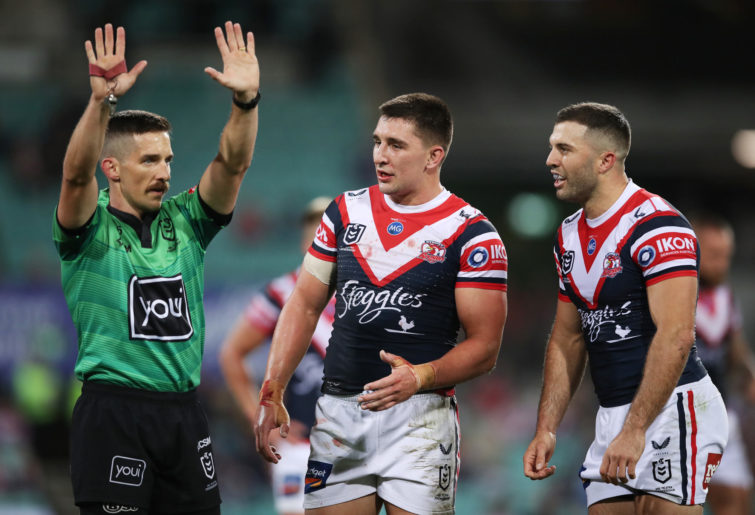LISTEN: Souths acting coach's blunt, one-word response to Latrell centres question
A pretty emphatic answer from Ben Hornby!
Opinion
Gary Freeman once did something impossibly brave in a match at Carlaw Park, Auckland against the touring Australian team.
Or so it was at the time. The New Zealand halfback jumped up in front of rampaging Australian centre Mal Meninga to stop the giant.
What has Freeman’s action got in common with recent attempted tackles by Manly Sea Eagles forward Zac Saddler and, say, St George Illawarra prop Daniel Alvaro?
Pre-Freeman’s bravery, since 1908, the recommended front-on tackle had been below the waste and head to the side.
It had been a front-on tackle perfected by St George and Australian halfback Billy Smith in the 1960s against advancing forwards.
But in those times a big forward weighed 95 kilograms and a monster weighed 100 kilograms and they played under a three-yard and then five-yard rule and didn’t run ten-15 yards to charge on to the ball.
Nowadays, centres and wingers routinely weigh 100-plus kilograms.
Canterbury legend Steve Mortimer is now reputedly showing early signs of dementia. There has been footage of the halfback getting his head in the wrong place, in front of legs, when completing side-on not front-on tackles. Perhaps there’s a connection.

Bulldogs legends Terry Lamb and Steve Mortimer. (Photo by Mark Kolbe/Getty Images)
The Roosters’ James Tedesco was recently lauded for a saving, covering tackle in the Johnny Raper-Ron Coote classical side-on style, except Tedesco’s head was in front of the legs, so rarely is such a tackle performed now. Fortunately, Tedesco was not concussed.
Which leads to Saddler-Alvaro, and the most serious problem in the game.
Saddler had a metal plate inserted in his skull after suffering a depressed fracture against Newcastle. The Manly forward came off second best in a head clash with Knights counterpart Sauaso Sue.
Alvaro already had two teammates tackling an opponent chest-high on either side as he stood at full height in front in a recent game.
There was no tackle he could perform. There could only be a head clash, and there was. Alvaro went to the head bin.
The NRL’s crackdown on head-high tackles may be admirable in itself, but the Saddler-Alvaro incidents illustrate the greater problem.
A recent study showed defenders suffered more injuries than attackers.
If the NRL’s referees were to simulate the incidents that led to head-high penalties since the crackdowns, they would make several observations. Those at home should not try this down at the park.
The referees would notice none of the penalised incidents included a clenched fist, an automatic action when performing the lethal stiff-arm tackles of Smith’s era.
They would also notice some were unavoidable reflex actions, part of the game, and there was nowhere else to put the arm, and contact was often minimal.
By all means penalise blatant high tackles, employ send-offs when necessary, but understanding is called for, especially from Bunker officials who can mentally assume the positions of participants at normal speed.

(Photo by Matt King/Getty Images)
The greater threat of head injuries arises from the friendly fire among defenders coached to go high and lock up the ball, or accidental defender-attacker head contact, as illustrated by Saddler-Sue.
Such contact seemingly happens every game now. It’s inevitable and it’s frightening.
There is no more frightening sight than a 120-kilogram forward running from the figurative back fence from a kick-off to take the ball and running into a figurative brick wall of defenders: a contest of the gymnasiums.
When commentators say don’t go down there, they really mean the danger is greater because there are multiple defenders in the tackle, and heads get in the wrong place.
When the stats show a forward has run multiple post-contact metres, what they mean is he has run with two defenders hanging off him before another goes around the legs.
A legs tackle would mean no post-contact metres but the attacker could get a pass away, and that’s what defence is now about: having multiple defenders above the waste locking up the ball.
Expect more head injuries from friendly fire. It’s inevitable.
Is there a solution? Yes.
Adopt rugby union’s no-tackling-above-the-chest rule. This would initially cause mayhem, with multiple penalties and games ruined, and it would mean a revolution, or rather a reversion.
It would mean reverting to one tackler below, one up top to lock up the ball as teams adjusted to the game that once existed.
No more multiple tacklers, and perhaps cricket scores to start, but much-reduced concussions and high tackles.
Having already changed the game through rules changes that have speeded it up and accentuated the differences between top and bottom, the NRL just has to decide what sort of game it wants.